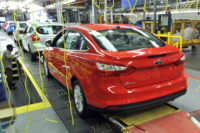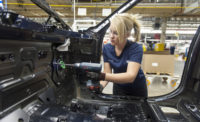MARTORELL, Spain—SEAT is employing two collaborative robots at its assembly plant here to apply nameplates on the rear doors of Ibiza and Arona hatchbacks. The cobots work at the beginning of the assembly line and apply the badges as the vehicles make their way down the assembly line, with no delay to the process and sharing space with the factory personnel.
The cobots, one on each side of the line, attach two kinds of lettering. The one on the left side of the cars selects the name Ibiza or Arona according to the model coming down the line, while the one on the right side places an “FR” badge on the corresponding versions. Custom end-of-arm tooling enables the robots to select different badges using suction cups, remove protective wrap on the rear, attach the badges to the car by applying pressure, remove protective wrap on the front, and deposit the wrap in a recycling bin.
Vision systems guide the robots during the process to ensure accurate placement. All this happens as the vehicles move along the assembly line. The process is performed while the cars are in motion, without the need to stop the line.
The workstation is equipped with an encoder and control devices that adapt to any change in the speed of the line. In addition, the process is accomplished without any physical separation between the robots and people working on the line.
“Collaborative robots enable us to be more flexible, more agile and more efficient,” says Rainer Fessel, Ph.D., director of the plant.
The factory employs some 20 cobots, which are used for ergonomically challenging operations. For example, a cobot was recently deployed near the end of the assembly line to adjusts the side moldings of the SEAT Arona. The robot is equipped with a roller that applies pressure to the moldings while the cars are moving.
The factory has more than 2,000 industrial robots, as well as 8,000 workers. The plant turns out 2,400 vehicles daily, or one car roughly every 30 seconds.





